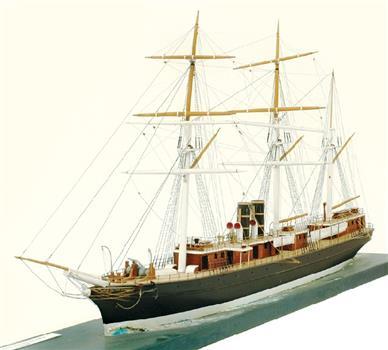Historical information
SS Iberia (1873-1903) was built by John Elder & Co. (Govan yard no.162 Glasgow) and launched 6 December 1873 at a cost £151,600. However, due to strike delays, her maiden voyage was not until 21 October 1874. The Iberia was one of the last of the barque-rigged, clipper-bow type of steamer built for the Pacific Steam Navigation Company. At the time, she was also the second largest ship in world, after the Great Eastern.
In 1877, a joint Orient Line and Pacific Steam Navigation Co. venture began a fortnightly mail service, first sailing between England and Australia on 12 May 1880, via Gibraltar, Naples, Port Said, Ismalia, Suez, Colombo, Albany, Adelaide, Melbourne, Sydney.
Details:
- Tonnage: 4,671 g, 2,982 n.
- Dimensions: 433ft 6in (132.13m) x 45ft (13.72m) x 35ft 1in (10.69m).
- Powered by a single screw, compound inverted 2 cylinder; 750 NHP; 4,000 IHP engine with steam pressure of 70 lbs, 4 cylindrical boilers, 2 to each funnel.
- Speed 14 knots
- 1873 Passengers: 100 1st, 150 2nd, 340 3rd Class.
- 1893 Passengers: 140 first, 50 second, 800 third
Some significant dates in her history include:
- 1881: Replaced "Aconcagua" as standby vessel on the London - Suez- Melbourne - Sydney route
- 1882: Government transport during the Egyptian Arabi Pasha Campaigns
- 1883 Jan 25: Placed on regular service to Australia
- 1890 Jun 11: Reverted to the Liverpool - Valparaiso route
- 1893: Iberia sailed to Australia to replace a disabled ship. The journey via the Cape was non-stop at 14 knots in 32 days
- 1893- Fitted with triple expansion engine; 3 cylinders, 600 NHP; 4 cylindrical boilers; 13 knots; fitted by J.Rollo & Sons, Liverpool
- 1903: Broken up at Genoa.
1873 single screw, compound inverted, 2 cylinder; 750 NHP, 4000 IHP, Steam pressure 70 lbs, 4 cylindrical boilers, 2 to each funnel, 14 knots. Second largest ship in the world in 1874 (after the Great Eastern). Cost 151, 600 pounds.
1893 Triple expansion engine fitted. 3 cylinders 600 NHP, 4 cylindrical boilers, 15 knots, fitted by D Rollo and Sons, Liverpool
Physical description
The body of the model is carved and molded wood painted in black and white, the planked deck with detailed fittings and rigging, raised on a wooden base with simulated waves. At this time yards removed.
Inscriptions & markings
"Iberia"




